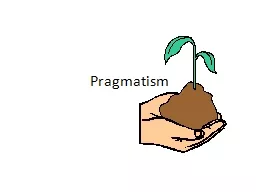

Pragmatism The root of the word Pragmatism is a Greek word meaning work It is primarily a 20th century philosophy developed by Americans Truth is what works in the real world We must keep the desired end in mind ID: 370812
Download Presentation The PPT/PDF document "Pragmatism" is the property of its rightful owner. Permission is granted to download and print the materials on this web site for personal, non-commercial use only, and to display it on your personal computer provided you do not modify the materials and that you retain all copyright notices contained in the materials. By downloading content from our website, you accept the terms of this agreement.
Slide1
PragmatismSlide2
Pragmatism
The root of the word Pragmatism is a Greek word meaning “work”.
It is primarily a 20th century philosophy developed by Americans.
Truth is what works in the real world. We must keep the desired end in mind.
Ideas should be applied to solving problems; including social problems. Slide3
Leaders in Pragmatism
Auguste Comte, 1798-1857
Not a pragmatist but emphasized
using science to solve social problemsSlide4
Leaders in Pragmatism
Charles Darwin, 1809-1882
Reality is not found in Being, but
in Becoming
Reality is open-ended, in process,
with no fixed end.Slide5
American Pragmatists
Charles Sanders Peirce, 1839-1914
Widely acknowledged as the father of pragmatism
Wrote an article on “How to make our Ideas Clear” in Popular Science Monthly that is regarded as the basis for pragmatism.
True knowledge of anything depends upon verfication of our ideas in actual experienceSlide6
American Pragmatists
William James, 1842-1910
The truth of an idea is its “workability”
Truth is not absolute and immutable; rather it is made in actual, real-life
James called his philosophy “radical empericism”
James’s 1907 book “Pragmatism”
did much to promote pragmatism.
Rufus Stimson, a leader in agricultural education, studied under James.Slide7
American Pragmatists
John Dewey, 1859-1952
Need to concentrate on real-life problems
Sought practical solutions for practical problems
How We Think
Felt Difficulty
Define the problem
Formulate possible solutions
Examine & Evaluate possible solutions
Accept or reject solutionsSlide8
Pragmatism and Education
Education should be preparation for life
Solving problems is important; therefore use real-life situations
Teaching methods should be varied and flexible
Education should be action oriented
Needs and interests of students should be consideredSlide9
Pragmatism and Education
Project approach to teaching is desirable
Curriculum is varied
A broad education is more desirableSlide10
The Pragmatist and the Chair
To a pragmatist, the use of the “chair” is important. What is the purpose of the chair and does it fulfil that purpose? The “workability” of a chair is the ultimate truth.